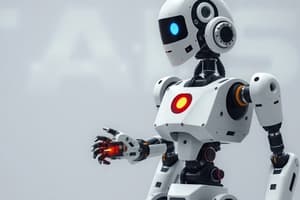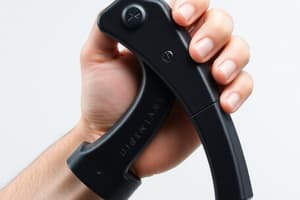Podcast
Questions and Answers
What is a key strategy employed by the team for their robot design?
What is a key strategy employed by the team for their robot design?
- Changing the programming language regularly
- Recreating the robot design every time a new mission arises
- Utilizing the same attachment and program for multiple missions (correct)
- Using multiple different attachments for each mission
How many times did the team recreate their robot's design throughout the season?
How many times did the team recreate their robot's design throughout the season?
- Four times
- Once
- Three times (correct)
- Twice
What innovation was introduced in the robot's programming this year?
What innovation was introduced in the robot's programming this year?
- Automated error detection during programming
- The use of graphical programming only
- Eliminating any need for sensors in programming
- My blocks to facilitate coding for turning (correct)
What contributed to the effectiveness of the robot's design?
What contributed to the effectiveness of the robot's design?
What was one benefit of using a portable laptop for programming during the competition?
What was one benefit of using a portable laptop for programming during the competition?
Why was programming considered fun by the team?
Why was programming considered fun by the team?
What feature of the robot design helps improve traction?
What feature of the robot design helps improve traction?
What is a significant aspect of the team's approach to missions this year?
What is a significant aspect of the team's approach to missions this year?
Flashcards
Robot Design Process
Robot Design Process
The process of improving a robot's design over time, often through experimentation and feedback.
Reusing Attachments and Programs
Reusing Attachments and Programs
A strategy to reduce the complexity of robot operations by reusing the same attachment and program for multiple tasks.
My Blocks
My Blocks
Special blocks of code that allow for easier and more efficient programming, specifically for making turns of specific degrees.
Program Optimization
Program Optimization
Signup and view all the flashcards
Collaborative Attachment Design
Collaborative Attachment Design
Signup and view all the flashcards
Robot Efficiency
Robot Efficiency
Signup and view all the flashcards
Adapted Research and Successes
Adapted Research and Successes
Signup and view all the flashcards
Robot Game Fun
Robot Game Fun
Signup and view all the flashcards
Study Notes
Robot Design and Competition
- Robot Specifications:
- Four drive motors
- Two color sensors
- Rubber wheels with almost flat surfaces for good traction
- Two attachments
Competition Strategy
- Repetitive Missions: Use the same attachment and program multiple times in one run.
- Single Missions: Primarily focusing on single missions for first-year competitions.
Design Process
- Iterative Design: The design evolved over the season.
- Three Iterations: The robot design was recreated three times.
- Initial Design Issues: First model too large, second model insufficiently strong.
- Gear Research and Integration: Changes based on gear research and video studies.
- Collaborative Design: Multiple team members worked on each attachment to optimize the design.
Innovation
- New Features: Incorporating new features adapted from other teams.
- Increased Motor Power: Modifying motor power to complete missions.
- Coding Enhancements: Developing "my blocks" for easier and more precise turns.
- Turn Adjustments: Utilized "my blocks" for programmed turns of various angles.
Mechanical Design
- Compact and Efficient: Not overly large but fast and efficient mechanically.
- Attachment Retention: Keeping the attachments on the robot as long as possible throughout a match to increase game efficiency.
Programming
- Constant Testing and Adjustment: Continuous testing and adjustments were made during the season to ensure accurate programs.
- Portable Laptop: A portable laptop allowed for last-minute program changes, improving efficiency.
Team Dynamics and Experience
- Collaborative Problem Solving: Teamwork and pooling knowledge accelerated problem-solving.
- Improved Efficiency: Better team dynamics and efficiency, leading to faster and better solutions.
- Enjoyable Experience: Team found programming and mission completion enjoyable and rewarding.
Studying That Suits You
Use AI to generate personalized quizzes and flashcards to suit your learning preferences.




